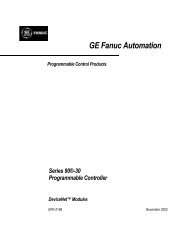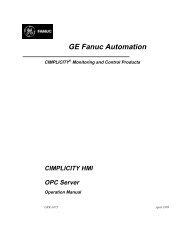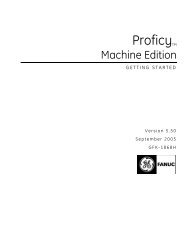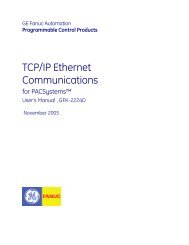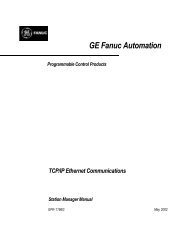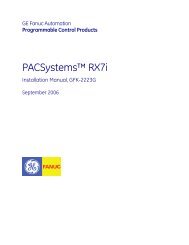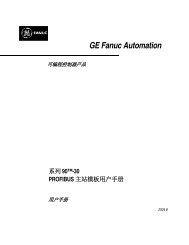Series 90-70 Genius Bus Controller Manual, GFK-2017
Series 90-70 Genius Bus Controller Manual, GFK-2017
Series 90-70 Genius Bus Controller Manual, GFK-2017
- No tags were found...
You also want an ePaper? Increase the reach of your titles
YUMPU automatically turns print PDFs into web optimized ePapers that Google loves.
3Configuring the Device Reference AddressA device’s Reference Address is the beginning reference for its input and output data.The software automatically assigns the next available reference address within amemory type. If the address displayed is not appropriate, a different address can beentered. Discrete references must begin on a byte boundary (a byte boundary is anumber which is one greater than a multiple of 8, for example: 9, 17, or 25). If youassign a reference address out of sequence, the software will then continue toincrement that number for additional modules. For example, if you assigned thereference %I0401 to the first input module and it had 16 circuits, the software wouldnext assign %I0417 or %QI0417 to an input or combination block. You could changethis to a different address. A message appears when the highest available address hasbeen assigned, although you may have skipped lower addresses.References for Devices having both Discrete and Word Inputs: For some busdevices (an example is the High-speed Counter block), the input data that is routinelybroadcast by the block consists of BOTH discrete and word-type data. For such ablock, the configured Reference Address represents three memory locations (in %I,%Q, and %AI memories) instead of the two (%I and %Q) assigned to other types ofblocks. This is shown in the Settings tab illustrated below.References for Inputs-only or Outputs-only Devices: An Inputs-only block uses onereference in %I or %AI memory for each circuit on the block. Similarly, a block withoutputs only requires one reference in %Q or %AQ memory only.References for Mixed I/O Blocks with both Inputs and Outputs: A <strong>Genius</strong> I/O blockthat has both inputs and outputs uses the same number of input and output references,regardless of the block’s actual I/O mix.An analog block with 4 inputs and 2 outputs requires four words of analog inputmemory and four words of analog output memory. The block only uses the first twooutput words, but the second two output words cannot be used for outputs becausethey cannot be assigned by the configuration software. However, they can be used forinternal registers in the application program.References for Redundancy: During operation, the CPU handles I/O data the sameway for redundant and non-redundant systems. For any redundant <strong>Bus</strong> <strong>Controller</strong> pairin the PLC, each CPU sweep the CPU receives a one set of bus inputs and sends oneset of bus outputs. The CPU does not maintain two sets of references for devices thatare set up for redundancy.<strong>GFK</strong>-<strong>2017</strong> Chapter 3 <strong>Bus</strong> <strong>Controller</strong> Configuration 3-25




